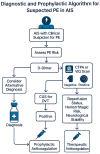Pulmonary Embolism in Acute Ischaemic Stroke: Evolving Evidence, Diagnostic Challenges, and a Novel Thromboinflammatory Axis Hypothesis
- PMID: 40724982
- PMCID: PMC12295995
- DOI: 10.3390/ijms26146733
Pulmonary Embolism in Acute Ischaemic Stroke: Evolving Evidence, Diagnostic Challenges, and a Novel Thromboinflammatory Axis Hypothesis
Abstract
Pulmonary embolism (PE) is an under-recognised yet serious complication in patients with acute ischaemic stroke (AIS), contributing significantly to morbidity and mortality. The interplay of traditional risk factors-such as immobility, endothelial dysfunction, and hypercoagulability-with AIS-specific conditions, including atrial fibrillation, malignancy, and reperfusion therapies, complicates both diagnosis and management. Despite available prophylactic strategies, including low-molecular-weight heparin and intermittent pneumatic compression, their use remains limited by bleeding concerns and a lack of tailored guidelines. This review synthesises the current evidence on the incidence, risk factors, pathophysiology, diagnostic approaches, and preventive strategies for PE in AIS, identifying critical gaps in risk stratification and clinical decision-making. We propose a novel mechanistic framework-the Brain-Lung Thromboinflammatory Axis Hypothesis-which posits that stroke-induced systemic inflammation, neutrophil extracellular trap (NET) formation, and pulmonary endothelial activation may drive in situ pulmonary thrombosis independent of deep vein thrombosis. This conceptual model highlights new diagnostic and therapeutic targets and underscores the need for stroke-specific VTE risk calculators, biomarker-guided prophylaxis, and prospective trials to optimise prevention and outcomes in this vulnerable population.
Keywords: anticoagulation; prophylaxis; pulmonary embolism; risk stratification; stroke.
Conflict of interest statement
S.M.M.B. reports leadership or a fiduciary role in another board, society, committee, or advocacy group, paid or unpaid, with the National Cerebral and Cardiovascular Center (Osaka, Japan) as the Visiting Director (2023–2025);
Figures




Similar articles
-
Combined intermittent pneumatic leg compression and pharmacological prophylaxis for prevention of venous thromboembolism.Cochrane Database Syst Rev. 2022 Jan 28;1(1):CD005258. doi: 10.1002/14651858.CD005258.pub4. Cochrane Database Syst Rev. 2022. PMID: 35089599 Free PMC article.
-
Neuromuscular electrical stimulation for the prevention of venous thromboembolism.Cochrane Database Syst Rev. 2017 Nov 21;11(11):CD011764. doi: 10.1002/14651858.CD011764.pub2. Cochrane Database Syst Rev. 2017. PMID: 29161465 Free PMC article.
-
Stopping anticoagulation for isolated or incidental pulmonary embolism: the STOPAPE RCT protocol.Health Technol Assess. 2024 Jun;29(11):1-17. doi: 10.3310/HRCW7937. Health Technol Assess. 2024. PMID: 38970429 Free PMC article.
-
Catheter-directed therapies for the treatment of high risk (massive) and intermediate risk (submassive) acute pulmonary embolism.Cochrane Database Syst Rev. 2022 Aug 8;8(8):CD013083. doi: 10.1002/14651858.CD013083.pub2. Cochrane Database Syst Rev. 2022. PMID: 35938605 Free PMC article.
-
Standard- versus extended-duration anticoagulation for primary venous thromboembolism prophylaxis in acutely ill medical patients.Cochrane Database Syst Rev. 2024 Dec 4;12(12):CD014541. doi: 10.1002/14651858.CD014541.pub2. Cochrane Database Syst Rev. 2024. PMID: 39629741
References
-
- Rinde L.B., Smabrekke B., Mathiesen E.B., Lochen M.L., Njolstad I., Hald E.M., Wilsgaard T., Braekkan S.K., Hansen J.B. Ischemic Stroke and Risk of Venous Thromboembolism in the General Population: The Tromso Study. J. Am. Heart Assoc. 2016;5:e004311. doi: 10.1161/JAHA.116.004311. - DOI - PMC - PubMed
-
- Sherman D.G., Albers G.W., Bladin C., Fieschi C., Gabbai A.A., Kase C.S., O’Riordan W., Pineo G.F., PREVAIL Investigators The efficacy and safety of enoxaparin versus unfractionated heparin for the prevention of venous thromboembolism after acute ischaemic stroke (PREVAIL Study): An open-label randomised comparison. Lancet. 2007;369:1347–1355. doi: 10.1016/S0140-6736(07)60633-3. - DOI - PubMed
Publication types
MeSH terms
Substances
LinkOut - more resources
Full Text Sources
Medical

